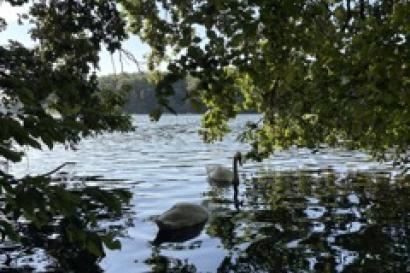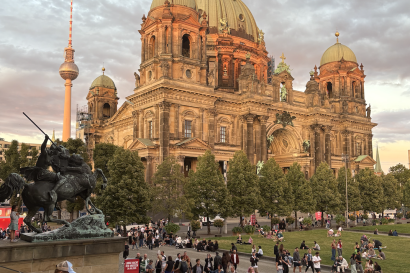One of the biggest questions I had before arriving in Berlin was whether I would appreciate the architecture. To cut things short, I genuinely do, but in a different way than one would in an older city such as Paris or Vienna. I live in Mitte and just a block away from Kreuzberg. This puts me in the eastern part of the city not far from where the Berlin Wall once stood. The best way to describe Berlin's cityscape is as a messy collage, which I also think pairs well with the grungy aesthetics of its citizens. It consists of restored Prussian facades directly next to East German pragmatic construction. Newer reunification buildings now look for a middle ground between concrete and glass. One of my favorite buildings in the area has an original pre-war foundation with four busts above the ground floor windows. One of the heads broke off some time ago, and the whole area is covered in graffiti. The rest is a sleek concrete apartment building. The side has green paint poured from the top, which seems like an artistic take on recreating mildew found on old structures. Directly next to it is a traditional East German tiled exterior, which uses a pale blue and white one would rarely find in the States.
Comparing this city style to somewhere like Boston, Massachusetts, not far from where I grew up, is like apples and oranges. I have been told the summertime gets busier in Berlin, but the city has a relatively relaxed pace as of now. The streets possess a small but constant stream of pedestrians alongside the bikers, cars, and buses. Perhaps this comes from the nearly 900 square kilometers the city encompasses compared to just over 200 square kilometers in New England. Berlin is also a much bigger city in population, and neighborhoods seem more well-mixed in terms of apartments and local businesses than back home. Still, I think the massive Soviet-style apartments in my part of town fit its appeal. Some say the concrete facades are a monstrosity to look at. Still, there's also an appreciation to be found in its pragmatic beatuity, especially once the leaves come out in a month or two. It's incredible to think how fast a city like Berlin was rebuilt in just a few decades after WWII. This also brings up the point that Berlin is still developing and dealing with its own issues of gentrification. There is active construction all over the city, especially in the former East. Talk of rising prices in a city known for the arts has caused alarm for a reduction in the city’s grungy charm. Still, the cost of an apartment in Berlin is half that of Boston. Boston’s cityscape is a more traditional colonial style alongside brownstones and modern skyscrapers, but with a price that high, is the traditional beauty worth it? I find it's the community you find wherever you are that makes a place worth living in. Its style enacts only a hollow descriptor. Long story short, I feel as if I've quickly adjusted to what some may call the monstrous recollections of East Berlin's communist past. I actually think it gives the city a cozy feel. The Soviet architecture, paired with the remains of its Prussian past, makes the city feel like a place for the people, which I have come to admire.

Corey Brown
<p>Guten Tag! Ich heiße Corey! I come from a small town named Groveland, Massachusetts about an hour north of Boston and now study at Brandeis University in Waltham, Massachusetts. I have a double major in Film and German with a minor in Studio Art and am studying abroad in Berlin Spring 2022. In my free time I tap dance (for the past 15 years), finger paint with oils on canvas, and direct an improv comedy podcast. In Berlin I'm super excited to live in a city for the first time and experience the hustle bustle on a daily basis.</p>







